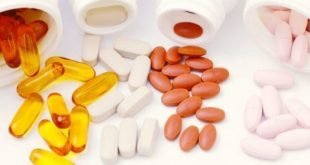 Spring is a wonderful time of the year, but only if you are allergic.
Spring is a wonderful time of the year, but only if you are allergic.
Alas, some people have a view of the blooming gardens evokes not joy but tears from eyes and sneezing.
Seasonal allergies can be and the true cross. When Allergy cross react with the same symptoms on other plants and food products. For example, if you are allergic to birch pollen a person can react to the pollen of other trees and fruits that grow on these trees, and some other foods.
Urban residents are more prone to seasonal allergies than people in villages. Exhaust fumes change the chemical structure of pollen and polluted air along with the pollen agents increase the population of Allergy.
The cause of spring allergies (or hay fever as it is called by doctors) is the pollen of flowering plants. These are tiny particles that are easily carried by the wind, and spring for several weeks, the air is literally full of them. By itself, the pollen safe, but in some people the immune system mistakenly begins to attack trapped in the body of the pollen grains. This affects mostly the eyes and nose, as their surfaces are very sensitive, and by getting pollen not protected. The result is inflammation, which causes watery eyes, runny nose and other Allergy symptoms. Allergen may be a pollen of any one plant or several.
Here are the most common myths about allergies, which the doctor told the skin oncologist, allergist-immunologist Elmira Zubova.
Myth 1. Hay fever causes poplar fluff
By itself, poplar fluff very rarely causes an allergic reaction, however its main danger lies in the fact that he is able to afford to carry pollen and spores of allergenic plants, which include:
– trees and shrubs (birch, alder, hazel, willow, oak, chestnut, poplar, ash, elm);
– grasses (Timothy, ryegrass, fescue, foxtail, bluegrass, wheat grass, rye, wheat);
– weeds (pigweed, ragweed, hemp nettle, wormwood).
Myth 2. Hay fever is exacerbated in the spring when everything is blooming
Depending on what lane you live the symptoms of hay fever can occur both in spring and summer (and even autumn). If you have allergies, you need to know the “its” of allergenic plants and their flowering periods.
Celebrated three peaks of exacerbations of hay fever:
spring (April — may) caused by tree pollen;
– summer (June — August) associated with the pollen of gramineous plants;
– autumn (August — October), caused by pollen of weeds (ragweed, mugwort).
Myth 3. Allergy is an inherited disease
Of course, in the development of allergic disease genetic predisposition plays an important role. The risk increases if someone in the family already suffers from allergies. If both parents are allergic, the chance of developing Allergy in their child is increased to 70-80%. However, even if none of the relatives I’m not allergic, the risk of its development is 15-20%, due to a violation of the environmental situation, the quality of food consumed, lots of preservatives in it, but also irrational and uncontrolled intake of drugs, leading to changes in the status of our immune system.
Myth 4. If childhood allergies were not, so it will not
Often the first signs of Allergy occur at the age from 5 to 20 years. However, it can appear in older age, which might be due to a person moving into a different climate zone, where there is a flowering of allergenic plants (as man could not even guess — before some allergies). Also person a can live for years with allergies, mistakenly considering it as trivial runny nose, a cold or bronchitis. As soon as you notice such symptoms as itchy nose, itchy eyes, watery eyes, uncontrollable sneezing, profuse runny nose, cough or difficulty breathing, immediately consult a specialist. Such complaints can be the beginning of the development of pollinosis.
Myth 5. Allergy is when a lot of sneezing and watery eyes
Of course, the most common manifestation of hay fever is itchy nose, mucous discharge from the nose, sneezing (called allergic rhinitis), watery eyes, red eyes (allergic conjunctivitis). In susceptible may suddenly start coughing, difficulty breathing, shortness of breath — this may have already starting talking about pollen bronchial asthma. However, for hay fever and possible skin manifestations in the form of urticaria, angioedema, various dermatitis, blisters, itching. Much rarer, but still sometimes found in lesions of the urogenital tract in the form of vulvovaginitis, urethritis, cystitis or nephritis, and involvement of the gastrointestinal tract, which can manifest as nausea, vomiting and abdominal pain.
Myth 6. Allergy to be cured is impossible
Most Allergy medications are aimed at treating symptoms of the disease rather than the treatment of its causes. To date, the method ASIT (allergen specific immunotherapy) is the only treatment that can cure the cause of the disease, and after cessation of therapy the symptoms of the disease are not reopened, and there is a long stable remission. In the process of ASIT in the body’s immune system are complex reactions, resulting in switching the immune response from an allergic to a normal.
Myth 7. Allergy, in principle, harmless, and it can’t be much of a treat
Allergies to treat a must, and under the supervision of a specialist — an allergist-immunologist. Unfortunately, many people for many years self-medicating, not knowing that inadequate treatment of hay fever may lead to serious complications: sinusitis (inflammation of the sinuses), otitis media (middle ear infection), the formation of cysts of the paranasal sinuses, polyps, as well as pollen bronchial asthma.
Myth 8. Allergological examination is very expensive
For a competent specialist it will be enough for you, ask specific questions, direct you to the necessary research and to conduct a series of tests. This will be enough to determine the specific allergens that trigger an allergic reaction.
The symptoms of seasonal allergies
Signs of seasonal allergies can be confused with respiratory symptoms: runny nose, sneezing, itching of the nose and eyes, redness and inflammation of the eye. The difference is that when seasonal allergies not body temperature rises. With worsening of the clinical picture appear cough, wheezing, attacks of breathlessness down to asthma attack. Typically, the symptoms appear every year, and every year the clinical picture increases, if there is no some specific treatment.
Diagnosis of seasonal allergies
If all these symptoms associated with seasonality, physician or pediatrician (if patient is a minor) may suspect the presence of an Allergy and guide patient to an allergist. That, in turn, assesses the heredity (are there any symptoms of allergies in three generations), experience allergies, asks whether the anti-allergic therapy. Then apply specific methods of diagnosis:
– skin tests – are conducted outside of an exacerbation and not in the flowering period, as during the skin test can aggravate an immune response or cause an exacerbation, if it was not. Worldwide standard of diagnosis is a skin prick test. Skin drip the allergen, then the skin is punctured disposable plastic stinger (prick). Skin tests are held only in a medical establishment in the manipulation room, where there are all means of assistance in case of allergic reactions. Is the study only about 40 minutes along with the preparation and interpretation of the results;
screening methodology to identify specific antitank groups of allergens: pollen, dust, food, etc., so-called antibody class of immunoglobulin E. For this study is taken blood from a vein. Spend it at any time and during an exacerbation and in the period of flowering;
– molecular diagnostics – research to make the most accurate diagnosis. This is the third stage of diagnosis, when there is already a suspicion for a certain type of allergen or putative allergen identified. In this case, the method of molecular diagnostics allows to specify the allergen and to determine true Allergy or cross.
Before you 20 tips that you should follow to protect yourself from hay fever, to survive this spring and generally live life to the fullest, although previously it seemed that in the flowering season it is simply impossible:
In dry windy days try to stay home. In this weather the air is filled with more pollen. On the contrary, after the rain it gets much smaller, so this is the best time for a walk or out shopping.
Going outside, wear sunglasses. This is partly to help to protect your eyes from the pollen that irritates them.
Keep Windows closed in the car during a trip, especially outside the city.
In principle, try not to leave the city during the period of active flowering, as after the concentration of pollen of some plants and trees are much higher than in the city. For those who prefer to work in the beds in the garden or in the flowerbeds of her garden, it is recommended to postpone these classes until the end of the season of hay fever.
After returning home, take a shower and remove street clothes away. On your body and clothing are the smallest particles of pollen that support Allergy.
Dry laundered clothes in the room. On the street it should not do: there it can stick the pollen of flowering plants that cause allergies, as soon as the clothes you wear.
Use the air conditioner in the car and at home. There are special filters for the air that capture allergens.
Regularly make home cleaning, collecting dust with a vacuum cleaner (they have anti-Allergy HEPA filters).
Sleep with the Windows closed.
Watch out for Pets. If you are releasing them to walk on the street, in their fur can also collect pollen, which they will bring you home.
Take a shower and wash your hair before going to sleep. This will clean your skin and hair from the allergens, stuck to him during the day. The probability of nighttime allergies is significantly reduced.
In agreement with the doctor, start over-the-counter medicines. If spring allergies are antihistamines. It is preferable to use antihistamines 2nd and 3rd gen, as they are safer and less likely to cause drowsiness.
Orosite the nasal cavity with saline or distilled water. It will ease congestion and directly wash it of allergens and mucus.
The best way to deal with spring allergies — allergen-specific immunotherapy. In the course of it, the doctor will first determine what is causing your allergies, and then make a series of subcutaneous injections. They will allow the body to gradually “get used” to the allergen and reduce the severity of symptoms. To do these shots you need in advance, until the Allergy season has not yet arrived.
Avoid emotional and heavy physical exertion.
Possibly take in a climatic zone with a different calendar dusting, at the seaside or in the mountains, where concentration of pollen is significantly lower. Plan your vacation in advance learning the timing of flowering of allergenic plants in the vicinity of your chosen vacation spot.
During exacerbation of hay fever postpone scheduled operations, preventative immunizations and vaccinations.
Do not use drugs, cosmetics, homeopathic preparations or herbal medicine, if they are part of the allergenic extracts for you plants.
Always carry a “Passport patient allergic disease”, which will be provided by your allergist after a consultation and examination. The passport will include your surname, name and patronymic, date of birth, Allergy diagnosis, the spectrum of allergens to which you have identified sensitivity as well as a list of activities to eliminate exposure to the allergen. The passport is a list of drugs that should always be in your medicine Cabinet, you specify the order of measures in case of anaphylactic shock and the priority of application of medicines.
Start a “Diary of a patient with hay fever,” in which you must specify the date of onset of symptoms, how they were expressed, what treatment did you use, specifying the dosage, and the frequency of their application, and must note the date of the disappearance of Allergy symptoms.
In the period of exacerbation of hay fever it is necessary to observe specific hypoallergenic diet, the composition of which depends on the type of pollinosis.
Elmira Zubova notes: “More than half of the patients with pollinosis react to foods with similar characteristics with pollen allergens. This is known as cross-allergic reaction. That is why patients are advised compliance with a special hypoallergenic diet.”
Hypoallergenic diet for patients allergic to the pollen of grasses. That is impossible: cereal porridge and cereals, bran, bread, sausage, canned meats, dry mixes for sauces, honey and bee products, beer, whiskey, wheat vodka, kvass, coffee substitutes based on wheat, cocoa, strawberry, strawberry, citrus, soy, beans, peanuts, corn, sorrel, cereals herbal.
Hypoallergenic diet for patients allergic to the pollen from weeds. What is not: honey and bee products, sunflower seeds and sunflower oil, mustard, mayonnaise, melons (cantaloupe, watermelon), zucchini, eggplant, tomatoes, potatoes, spirits, tarragon, herbs and spices, chicory, citrus, bananas, garlic, carrots, beets, spinach.
Hypoallergenic diet for patients allergic to tree pollen. What is not: honey and bee products, fruit, apples, pears, kiwi, nuts, carrots, greens, spices, brandy, wine, birch juice, potatoes, tomatoes, cucumbers, onions.
© 2017, paradox. All rights reserved.





